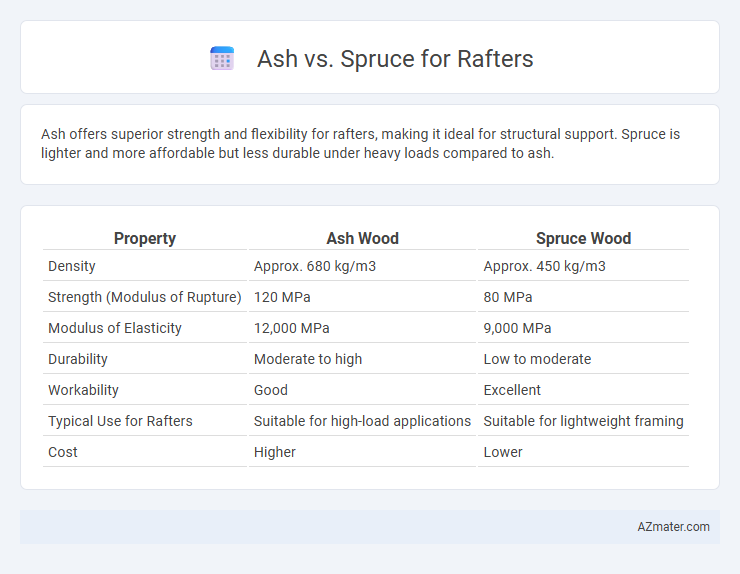Ash offers superior strength and flexibility for rafters, making it ideal for structural support. Spruce is lighter and more affordable but less durable under heavy loads compared to ash.
Table of Comparison
| Property | Ash Wood | Spruce Wood |
|---|---|---|
| Density | Approx. 680 kg/m3 | Approx. 450 kg/m3 |
| Strength (Modulus of Rupture) | 120 MPa | 80 MPa |
| Modulus of Elasticity | 12,000 MPa | 9,000 MPa |
| Durability | Moderate to high | Low to moderate |
| Workability | Good | Excellent |
| Typical Use for Rafters | Suitable for high-load applications | Suitable for lightweight framing |
| Cost | Higher | Lower |
Introduction: Comparing Ash and Spruce for Rafters
Ash and Spruce are popular wood choices for rafters due to their strength and workability. Ash offers superior hardness and shock resistance, making it ideal for structural support in roofing. Spruce provides excellent stiffness and is lighter, allowing easier handling and installation in rafter construction.
Wood Properties: Density and Strength
Ash wood exhibits a density ranging from 600 to 700 kg/m3, offering excellent strength and flexibility ideal for rafters requiring load-bearing capacity and shock resistance. Spruce has a lower density, approximately 400 to 470 kg/m3, with good strength-to-weight ratio, making it suitable for lightweight rafter applications where ease of handling and moderate strength are priorities. In structural use, ash provides superior durability and stiffness, while spruce is favored for its lighter weight and consistent grain, impacting the overall performance and longevity of rafter frameworks.
Durability and Longevity in Rafters
Ash offers high durability and excellent shock resistance, making it a strong choice for rafters exposed to heavy loads and stress. Spruce, while lighter and easier to work with, has moderate durability and may require additional treatment to withstand long-term exposure to moisture and pests. Ash rafters typically provide greater longevity under harsh conditions compared to spruce, extending the structural integrity of roofing frameworks.
Weight Considerations for Roof Structures
Ash offers greater density and strength than spruce, resulting in heavier rafters that provide enhanced load-bearing capacity, crucial for supporting heavy roofing materials or snow loads. Spruce, being lighter, reduces the overall roof weight, promoting easier handling and potentially lowering transportation and installation costs while still maintaining adequate structural integrity. Selecting between ash and spruce for rafters depends on balancing the need for weight efficiency with required strength and durability in roof construction.
Workability and Ease of Installation
Ash offers superior workability for rafters due to its straight grain and moderate hardness, allowing easier cutting, shaping, and nailing compared to spruce. Spruce, while lighter and more affordable, has a softer texture that can be prone to denting and splitting during installation, potentially complicating handling. Choosing ash for rafters enhances installation efficiency and durability, particularly in projects requiring precision and robust structural support.
Resistance to Decay and Insects
Ash wood exhibits moderate resistance to decay and insects but generally requires proper treatment for outdoor or structural use in rafters. Spruce, commonly used in construction, offers lower natural resistance to decay and insect attack, making it more susceptible unless pressure-treated or coated. For longer-lasting rafters, choosing ash with additional protective measures enhances durability compared to untreated spruce.
Cost Analysis: Ash vs Spruce
Ash rafters generally cost more than spruce due to their higher density and durability, making them a more expensive option upfront. Spruce offers a budget-friendly alternative with lower initial costs but may require more maintenance over time because of its softer wood characteristics. When assessing total expenses, including purchase and long-term upkeep, spruce often provides better value for projects with budget constraints.
Environmental Impact and Sustainability
Ash rafters offer a sustainable option due to ash trees' rapid growth and lower carbon footprint during harvesting compared to slower-growing species. Spruce rafters, while also renewable, are often sourced from managed forests with certifications like FSC, ensuring responsible harvesting practices and biodiversity conservation. Choosing ash or spruce for rafters supports environmentally conscious construction by utilizing renewable resources with minimal ecological disruption.
Common Applications in Construction
Ash and spruce are frequently used in rafter construction due to their distinct properties. Ash offers high strength and flexibility, making it ideal for load-bearing rafters in residential and commercial buildings. Spruce, valued for its lightweight and ease of handling, is commonly chosen for roof framing and truss systems in light-frame construction.
Conclusion: Choosing the Right Wood for Rafters
Ash offers superior strength and durability, making it ideal for rafters that require high load-bearing capacity and resistance to bending. Spruce provides a lightweight and cost-effective option with good stability, suitable for rafters in moderate structural applications. Selecting the right wood depends on balancing structural demands, budget constraints, and environmental factors to ensure longevity and performance in roof construction.

Infographic: Ash vs Spruce for Rafter
 azmater.com
azmater.com